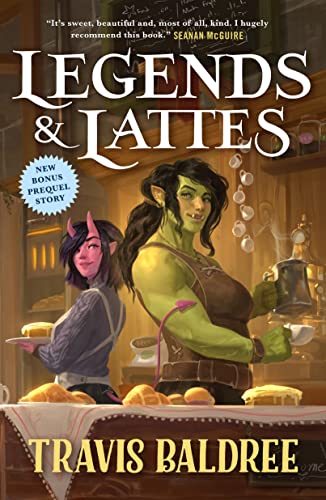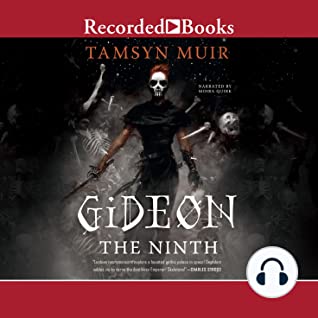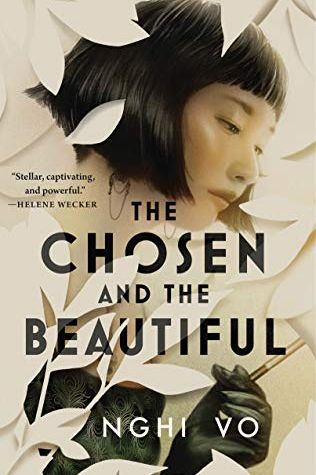Amazon Affiliate Link | Bookshop.org Affiliate Link Last year, I was delighted by A Marvellous Light, a gay murder mystery/romance in which Robin, a newly-made Baronet, is appointed to the wrong government office and is accidently drawn into the hidden world of magical society when shadowy forces think he knows more than he does. With a curseRead More
Nat reviews Legends and Lattes by Travis Baldree
Amazon Affiliate Link | Bookshop.org Affiliate Link I must confess that I’d seen the cover of Legends and Lattes pop up a number of times and thought to myself, eh, too much of a high fantasy book for my tastes. Well, I should know better by now than write off a book based on genre,Read More
Meagan Kimberly reviews Gideon the Ninth by Tamsyn Muir
Amazon Affiliate Link | Bookshop.org Affiliate Link Ready to cut loose from her life serving the Ninth House and a doomed future, Gideon makes plans to escape the planet, but Harrow has other plans for her. Harrow has been summoned by the Emperor to engage in a trial of necromantic skills and intellect. If eitherRead More
Danika reviews The Dawnhounds (Against the Quiet #1) by Sascha Stronach
Amazon Affiliate Link | Bookshop.org Affiliate Link This is a queer, Maori-inspired, pirate, biopunk fantasy with worldbuilding so intense that I will be honest, I often was not following it all. It takes place mid-war, during a tense stalemate, in a city that’s bio-engineered plants to be buildings, weapons, and almost everything else. Metal isRead More
Danika reviews Doughnuts and Doom by Balazs Lorinczi
Amazon Affiliate Link | Bookshop.org Affiliate Link I love silly, fluffy sapphic graphic novels. I also seek out queer witchy books to read in October. So I thought this book was going to be a slam dunk! It’s about Margot, a witch who runs a potions business out of her kitchen and starts off theRead More
Vic reviews The Jasmine Throne by Tasha Suri
Amazon Affiliate Link | Bookshop.org Affiliate Link Considering it’s commonly referred to as part of the Sapphic Trifecta of fantasy and sapphic fantasy is, in my professional opinion, the best genre there is, it seems almost criminal that it took me so long to get to it. Maybe it was intimidation (how often do popularRead More
Danika reviews Payback’s a Witch by Lana Harper
Amazon Affiliate Link | Bookshop.org Affiliate Link If you’re looking for a book equivalent of watching Hocus Pocus or Halloweentown–but as a bisexual romance novel–this is the book for you. Emmy Harlow left her childhood home of Thistle Grove after a humiliating breakup. She was determined to make a new life for herself in Chicago,Read More
Til reviews The Lock-Eater by Zack Loran Clark
Amazon Affiliate Link | Bookshop.org Affiliate Link The Lock-Eater tells the story of Melanie Gate, an orphan sent on an adventure with a gearling in a land of power-hungry wizards, invisible unicorns, humanoid animals, true friends, and cute seamstresses. This is a book that feels very aware of its adherence to the typical—the author definitely knowsRead More
Meagan Kimberly reviews The Dark Tide by Alicia Jasinska
Amazon Affiliate Link | Bookshop.org Affiliate Link Every year the witch queen of Caldella must choose a lover from the town to sacrifice to the dark tide, saving the island and its people from annihilation. Every year another boy is taken and everyone accepts it. But when Lina’s brother is in danger of becoming theRead More
Vic reviews The Chosen and the Beautiful by Nghi Vo
Amazon Affiliate Link | Bookshop.org Affiliate Link I will be completely honest—I really do not care very much for The Great Gatsby. This book, however, far exceeds its source material (*gasp* sacrilege!). This is everything I want out of a retelling of a classic novel, and I am so glad I read it. Nghi Vo’s The ChosenRead More
- « Previous Page
- 1
- 2
- 3
- 4
- 5
- 6
- …
- 10
- Next Page »



